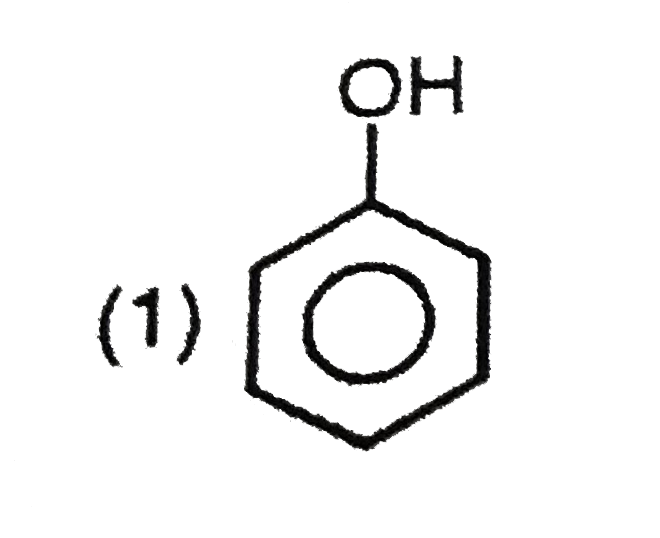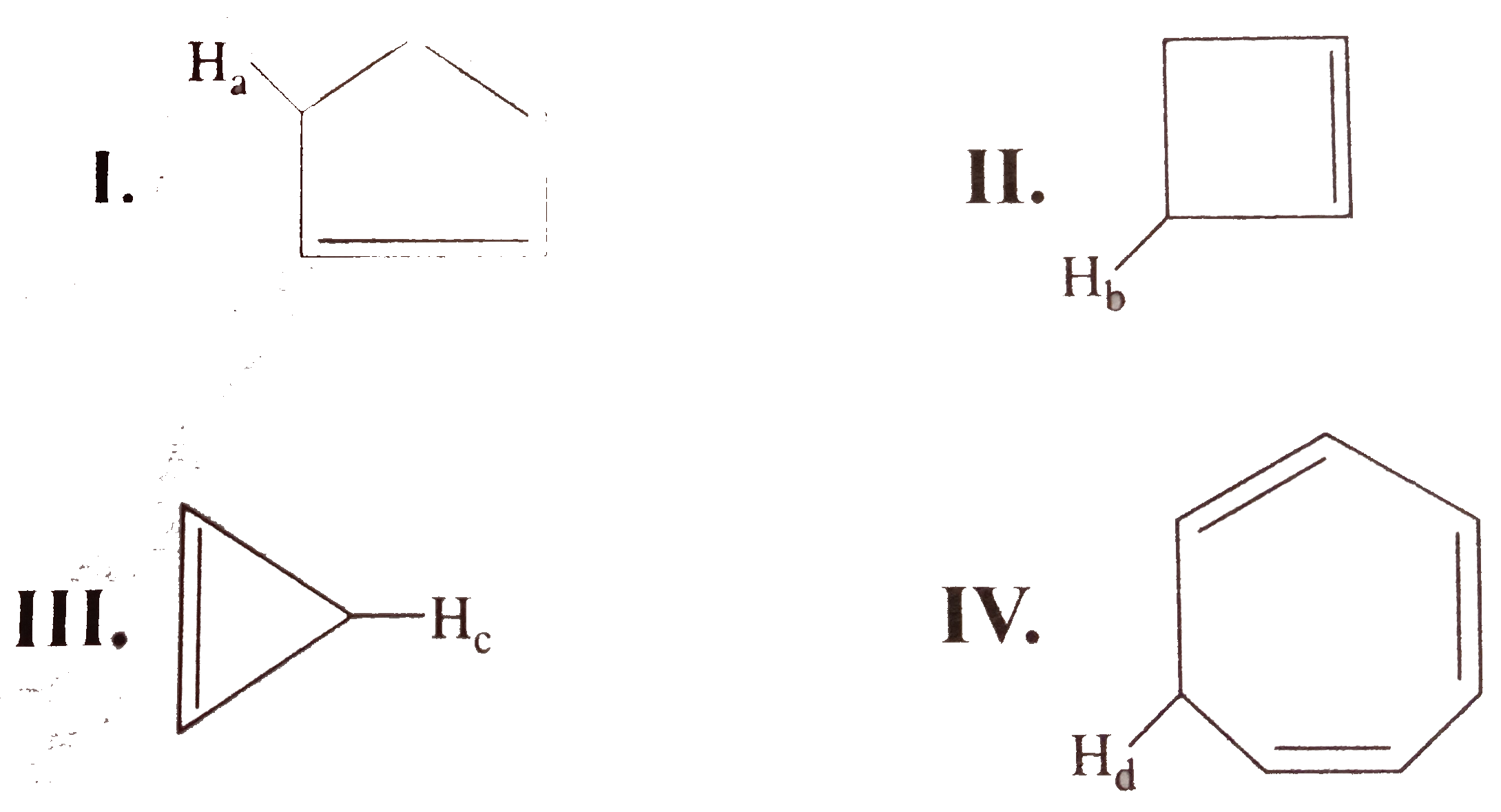Which is the following phenol has lowest pKa ?




The correct Answer is:D
To determine which phenol has the lowest pKa, we need to analyze the acidity of each phenol based on the presence of electron-withdrawing or electron-donating groups. The lower the pKa, the more acidic the compound is.
1. Understanding pKa and Acidity:
- pKa is a measure of acidity; lower pKa values indicate stronger acids. Acidity is related to the tendency of a compound to release H⁺ ions.
2. Identifying the Compounds:
- We have four phenolic compounds to analyze. Let's denote them as:
- Option 1: Phenol (C₆H₅OH)
- Option 2: p-Cresol (C₆H₄(CH₃)OH)
- Option 3: Ortho-fluorophenol (C₆H₄(OH)(F))
- Option 4: Ortho-chlorophenol (C₆H₄(OH)(Cl))
3. Analyzing Each Compound:
- Option 1 (Phenol): No electron-withdrawing or donating groups. It has moderate acidity.
- Option 2 (p-Cresol): Contains a methyl group (CH₃), which is an electron-donating group. This decreases acidity because it makes it harder to release H⁺.
- Option 3 (Ortho-fluorophenol): Fluorine is an electron-withdrawing group, which increases acidity. However, it can form intramolecular hydrogen bonds with the hydroxyl group, making it less likely to release H⁺.
- Option 4 (Ortho-chlorophenol): Chlorine is also an electron-withdrawing group. It stabilizes the phenoxide ion formed after the release of H⁺ and does not form intramolecular hydrogen bonds, making it easier for H⁺ to be released.
4. Comparing Acidity:
- Since p-Cresol is eliminated due to the electron-donating effect, we compare ortho-fluorophenol and ortho-chlorophenol.
- Ortho-fluorophenol has intramolecular hydrogen bonding, which hinders H⁺ release.
- Ortho-chlorophenol, on the other hand, stabilizes the phenoxide ion without the hindrance of intramolecular hydrogen bonding.
5. Conclusion:
- Therefore, ortho-chlorophenol (Option 4) has the lowest pKa value among the given phenols, making it the most acidic.
Final Answer:
The phenol with the lowest pKa is Option 4: Ortho-chlorophenol.
- pKa is a measure of acidity; lower pKa values indicate stronger acids. Acidity is related to the tendency of a compound to release H⁺ ions.
- We have four phenolic compounds to analyze. Let's denote them as:
- Option 1: Phenol (C₆H₅OH)
- Option 2: p-Cresol (C₆H₄(CH₃)OH)
- Option 3: Ortho-fluorophenol (C₆H₄(OH)(F))
- Option 4: Ortho-chlorophenol (C₆H₄(OH)(Cl))
- Option 1 (Phenol): No electron-withdrawing or donating groups. It has moderate acidity.
- Option 2 (p-Cresol): Contains a methyl group (CH₃), which is an electron-donating group. This decreases acidity because it makes it harder to release H⁺.
- Option 3 (Ortho-fluorophenol): Fluorine is an electron-withdrawing group, which increases acidity. However, it can form intramolecular hydrogen bonds with the hydroxyl group, making it less likely to release H⁺.
- Option 4 (Ortho-chlorophenol): Chlorine is also an electron-withdrawing group. It stabilizes the phenoxide ion formed after the release of H⁺ and does not form intramolecular hydrogen bonds, making it easier for H⁺ to be released.
- Since p-Cresol is eliminated due to the electron-donating effect, we compare ortho-fluorophenol and ortho-chlorophenol.
- Ortho-fluorophenol has intramolecular hydrogen bonding, which hinders H⁺ release.
- Ortho-chlorophenol, on the other hand, stabilizes the phenoxide ion without the hindrance of intramolecular hydrogen bonding.
- Therefore, ortho-chlorophenol (Option 4) has the lowest pKa value among the given phenols, making it the most acidic.
The phenol with the lowest pKa is Option 4: Ortho-chlorophenol.
Topper's Solved these Questions
- GENERAL ORGANIC CHEMISTRY IIBOOK - RESONANCE ENGLISHCHAPTER - GENERAL ORGANIC CHEMISTRY IIEXERCISE - Part-II: NSEC (Stage-I)
45 Videos
- GENERAL ORGANIC CHEMISTRY IIBOOK - RESONANCE ENGLISHCHAPTER - GENERAL ORGANIC CHEMISTRY IIEXERCISE - Part-III: Practice Test-2 (IIT-JEE (Advanced Pattern))
16 Videos
- GENERAL ORGANIC CHEMISTRY IIBOOK - RESONANCE ENGLISHCHAPTER - GENERAL ORGANIC CHEMISTRY IIEXERCISE - Exercise-3 Part:II JEE(MAIN) ONLINE PROBLEMS
16 Videos
- GASEOUS STATEBOOK - RESONANCE ENGLISHCHAPTER - GASEOUS STATEEXERCISE - ORGANIC CHEMISTRY(Hydrocarbon)
18 Videos
- GENERAL ORGANIC CHEMISTRY-IBOOK - RESONANCE ENGLISHCHAPTER - GENERAL ORGANIC CHEMISTRY-IEXERCISE - PART-III : PRACTICE TEST-19
1 Videos
Similar Questions
Knowledge Check
Which of the following is phenol ?
ACresolBCatecholCBenzenolDAll of theseWhich of the following acids has lowest pKa value?
ACH2∣NO2−O∣∣C−OHBCH2∣NO2−CH2−O∣∣C−OHCCH2∣Cl−O∣∣C−OHDCH3−Cl∣C∣Cl−O∣∣C−OHWhich of the following phenols has the largest pK, value (i.e., is least acidic) ?
A B
B C
C D
D
Which one of the following has lowest m.pt ?
View SolutionWhich of the following will have lower pKa value ?

View SolutionWhich of the following sulphate has the lowest solubility product ?
View SolutionWhich of the following ion has lowest magnetic moment?
View SolutionWhich of the following has lowest pKa value ?
View Solution
